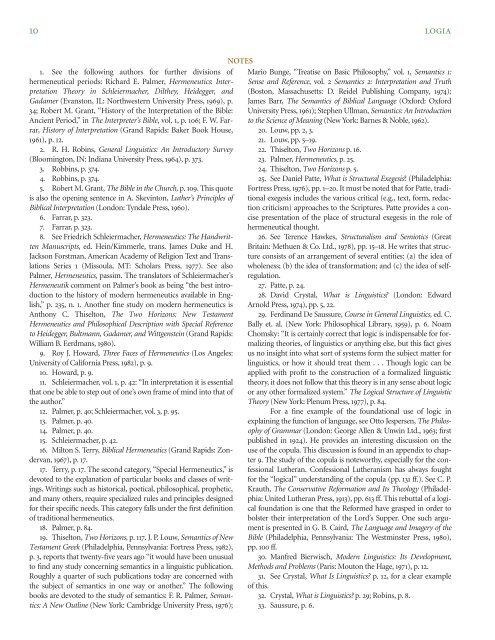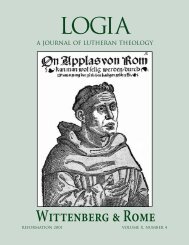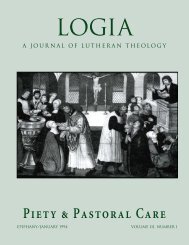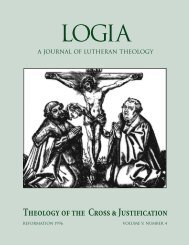04-2 Hermeneutics.pdf
04-2 Hermeneutics.pdf
04-2 Hermeneutics.pdf
- No tags were found...
You also want an ePaper? Increase the reach of your titles
YUMPU automatically turns print PDFs into web optimized ePapers that Google loves.
10 LOGIA1. See the following authors for further divisions ofhermeneutical periods: Richard E. Palmer, <strong>Hermeneutics</strong>: InterpretationTheory in Schleiermacher, Dilthey, Heidegger, andGadamer (Evanston, IL: Northwestern University Press, 1969), p.34; Robert M. Grant, “History of the Interpretation of the Bible:Ancient Period,” in The Interpreter’s Bible, vol. 1, p. 106; F. W. Farrar,History of Interpretation (Grand Rapids: Baker Book House,1961), p. 12.2. R. H. Robins, General Linguistics: An Introductory Survey(Bloomington, IN: Indiana University Press, 1964), p. 373.3. Robbins, p. 374.4. Robbins, p. 374.5. Robert M. Grant, The Bible in the Church, p. 109. This quoteis also the opening sentence in A. Skevinton, Luther’s Principles ofBiblical Interpretation (London: Tyndale Press, 1960).6. Farrar, p. 323.7. Farrar, p. 323.8. See Friedrich Schleiermacher, <strong>Hermeneutics</strong>: The HandwrittenManuscripts, ed. Hein/Kimmerle, trans. James Duke and H.Jackson Forstman, American Academy of Religion Text and TranslationsSeries 1 (Missoula, MT: Scholars Press, 1977). See alsoPalmer, <strong>Hermeneutics</strong>, passim. The translators of Schleiermacher’sHermeneutik comment on Palmer’s book as being “the best introductionto the history of modern hermeneutics available in English,”p. 235, n. 1. Another fine study on modern hermeneutics isAnthony C. Thiselton, The Two Horizons: New Testament<strong>Hermeneutics</strong> and Philosophical Description with Special Referenceto Heidegger, Bultmann, Gadamer, and Wittgenstein (Grand Rapids:William B. Eerdmans, 1980).9. Roy J. Howard, Three Faces of <strong>Hermeneutics</strong> (Los Angeles:University of California Press, 1982), p. 9.10. Howard, p. 9.11. Schleiermacher, vol. 1, p. 42: “In interpretation it is essentialthat one be able to step out of one’s own frame of mind into that ofthe author.”12. Palmer, p. 40; Schleiermacher, vol. 3, p. 95.13. Palmer, p. 40.14. Palmer, p. 40.15. Schleiermacher, p. 42.16. Milton S. Terry, Biblical <strong>Hermeneutics</strong> (Grand Rapids: Zondervan,1967), p. 17.17. Terry, p. 17. The second category, “Special <strong>Hermeneutics</strong>,” isdevoted to the explanation of particular books and classes of writings.Writings such as historical, poetical, philosophical, prophetic,and many others, require specialized rules and principles designedfor their specific needs. This category falls under the first definitionof traditional hermeneutics.18. Palmer, p. 84.19. Thiselton, Two Horizons, p. 117. J. P. Louw, Semantics of NewTestament Greek (Philadelphia, Pennsylvania: Fortress Press, 1982),p. 3, reports that twenty-five years ago “it would have been unusualto find any study concerning semantics in a linguistic publication.Roughly a quarter of such publications today are concerned withthe subject of semantics in one way or another.” The followingbooks are devoted to the study of semantics: F. R. Palmer, Semantics:A New Outline (New York: Cambridge University Press, 1976);NOTESMario Bunge, “Treatise on Basic Philosophy,” vol. 1, Semantics 1:Sense and Reference, vol. 2 Semantics 2: Interpretation and Truth(Boston, Massachusetts: D. Reidel Publishing Company, 1974);James Barr, The Semantics of Biblical Language (Oxford: OxfordUniversity Press, 1961); Stephen Ullman, Semantics: An Introductionto the Science of Meaning (New York: Barnes & Noble, 1962).20. Louw, pp. 2, 3.21. Louw, pp. 5–19.22. Thiselton, Two Horizons p. 16.23. Palmer, <strong>Hermeneutics</strong>, p. 25.24. Thiselton, Two Horizons p. 5.25. See Daniel Patte, What is Structural Exegesis? (Philadelphia:Fortress Press, 1976), pp. 1–20. It must be noted that for Patte, traditionalexegesis includes the various critical (e.g., text, form, redactioncriticism) approaches to the Scriptures. Patte provides a concisepresentation of the place of structural exegesis in the role ofhermeneutical thought.26. See Terence Hawkes, Structuralism and Semiotics (GreatBritain: Methuen & Co. Ltd., 1978), pp. 15–18. He writes that structureconsists of an arrangement of several entities: (a) the idea ofwholeness; (b) the idea of transformation; and (c) the idea of selfregulation.27. Patte, p. 24.28. David Crystal, What is Linguistics? (London: EdwardArnold Press, 1974), pp. 5, 22.29. Ferdinand De Saussure, Course in General Linguistics, ed. C.Bally et. al. (New York: Philosophical Library, 1959), p. 6. NoamChomsky: “It is certainly correct that logic is indispensable for formalizingtheories, of linguistics or anything else, but this fact givesus no insight into what sort of systems form the subject matter forlinguistics, or how it should treat them . . . Though logic can beapplied with profit to the construction of a formalized linguistictheory, it does not follow that this theory is in any sense about logicor any other formalized system.” The Logical Structure of LinguisticTheory (New York: Plenum Press, 1977), p. 84.For a fine example of the foundational use of logic inexplaining the function of language, see Otto Jespersen, The Philosophyof Grammar (London: George Allen & Unwin Ltd., 1963; firstpublished in 1924). He provides an interesting discussion on theuse of the copula. This discussion is found in an appendix to chapter9. The study of the copula is noteworthy, especially for the confessionalLutheran. Confessional Lutheranism has always foughtfor the “logical” understanding of the copula (pp. 131 ff.). See C. P.Krauth, The Conservative Reformation and Its Theology (Philadelphia:United Lutheran Press, 1913), pp. 613 ff. This rebuttal of a logicalfoundation is one that the Reformed have grasped in order tobolster their interpretation of the Lord’s Supper. One such argumentis presented in G. B. Caird, The Language and Imagery of theBible (Philadelphia, Pennsylvania: The Westminster Press, 1980),pp. 100 ff.30. Manfred Bierwisch, Modern Linguistics: Its Development,Methods and Problems (Paris: Mouton the Hage, 1971), p. 12.31. See Crystal, What Is Linguistics? p. 12, for a clear exampleof this.32. Crystal, What is Linguistics? p. 29; Robins, p. 8.33. Saussure, p. 6.
















